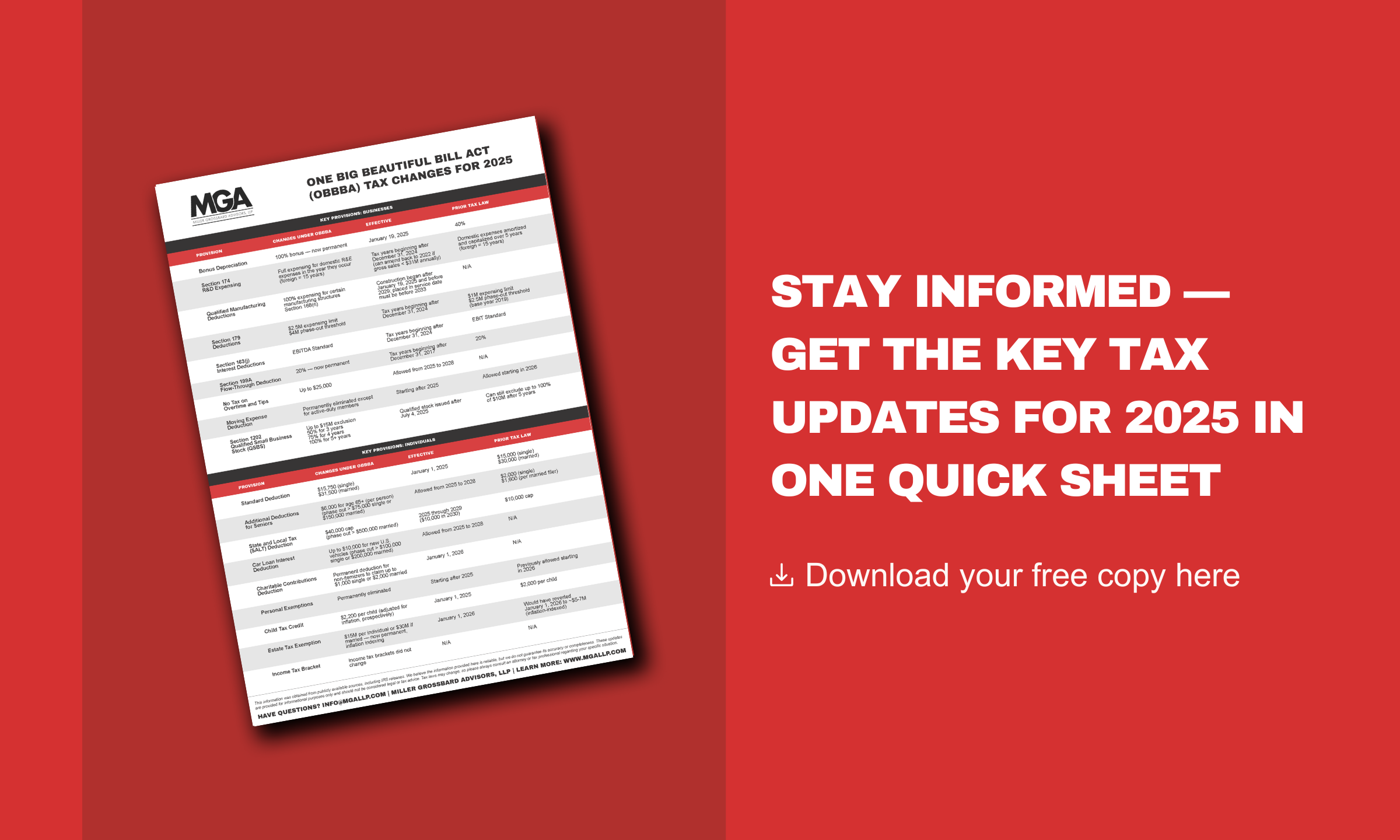Shortly after the tax bill was passed, and in response to questions coming from our real estate clients, we promised to create a summary of the new tax bill provisions that specifically affected our real estate clients.
After countless cups of coffee, pounds of peanut M&M’s, and exhaustive reading, we have pulled together a summary guide to the provisions of the new tax bill affecting real estate. Despite our best efforts, there are provisions in this new bill that lack clarity. In those situations, we have tried to provide our best interpretation and identify areas that still need guidance from the Treasury. As always, we will continue to update you as clarifications are issued that allow us to develop the best plans to use this tax bill to your advantage.
We know we said summary, but even so, our review is pretty lengthy. Condensing a 1,100-page bill into a one-page bullet point summary is hard.
Interest Expense Deduction Limitation
Like most of the provisions in this new tax bill, the reality of who it affects is less scary than most people realize. Before we talk about the limitation, let’s first look at who it DOES NOT affect – entities with average gross receipts of under $25 million.
Now, you need to take into account that for entities that are under common control, you may need to aggregate (an area that Treasury needs to clarify) the gross receipts for all these entities to see if you meet the under $25 million gross receipts. Common ownership is defined in Sec 414 of the IRS code, and it is fairly complex. As a rule of thumb, if you own less than 50% in different entities, then the aggregation rule does not impact you. If you are unsure, please call us, and we can walk through the common control test with you.
Now, if your average gross receipts are over $25 million, you have another out because you are in the business of owning and operating real estate: You can elect to use a longer straight-line depreciation method (ADS life). For highly leveraged deals, this may be a good alternative – give up some depreciation in the short-term for the full interest deduction.
So, if you are comfortable that you are not subject to the common control provisions, you can stop reading now and go to the next topic. If you think you are subject to this limitation, give your team at MGA a call so we can talk about it with you.
Depreciation, Bonus, Section 179 and Cost Segregation
Geez, I don’t know about you, but we’ve just started, and I’m already getting worn out! Grab an energy drink, and let’s move on.
Qualified leasehold improvement property, qualified retail improvement property, and qualified restaurant property will go away for any property placed in service after 12/31/2017.
Bonus depreciation goes from 50% to 100% for property acquired and placed into service after 9/27/2017.
The word “acquired” is important here. The new law expressly states that if there was a binding contract to acquire the property in place before 9/28/2017, then the property was not acquired after 9/27/2017. Therefore, it must be depreciated using the old rules.
What does this mean? Well, in a situation where construction was ongoing at the end of 2017, the contract for the construction was likely entered into prior to the 9/28 cutoff. Therefore, the construction would only be eligible for the 50% bonus depreciation allowance if it was placed into service in 2017. Any assets placed into service in 2018 would be subject to the 40% bonus rate (the amount that would have been allowed under the previous law).
Other bonus depreciation items to note:
- The bonus depreciation percentage is scheduled to start decreasing in 2023, but it is anyone's guess as to what the law will be at that time.
Bonus depreciation is now allowed on used property acquired and placed into service after 9/27/2017, so long as the taxpayer has not used the property at any time prior to the acquisition, and as long as it meets the other requirements of qualifying property (generally meaning it must have a recovery period of 20 years or less).
There are new regulations around 179 expensing, but due to the 100% bonus (if corrected) for QIP, 179 will be less of a concern.
However, the following assets, which do not qualify as QIP, do qualify to be expensed under 179:
- Roofs
- HVAC property
- Fire protection and alarm systems
- Security systems
The limits in 2018 will be $1,000,000 with the phase-out dollar-for-dollar beginning at $2,500,000 of qualifying assets placed in service during the same tax year.
No discussion of depreciation would be complete without bringing up Cost Segregation Studies (“CSS”). While many people thought the new bill would be the death of CSS, that is not the case – CSS lives on! Unless you elect the ADS method to avoid the interest expense deduction limitation, CSS still provides the benefit of accelerating depreciation expense on real estate. Even if using the ADS method, CSS may be tax advantageous to allocate costs for partial disposition purposes.
Property Tax Deduction
Time to take a little break – stand up, touch your toes (knees or shins can be substituted for those not yoga enthusiasts), and let’s take an easy topic.
Contrary to early fears, the property tax deduction has NOT been curtailed for businesses, only for itemized deduction purposes. Enough said, let’s move on to another easy topic.
Active vs. Passive
Again, contrary to early fears, there is little change in the classification of whether you are active or passive relative to your investments/activities. One area, which we will discuss more in our next exciting topic, is triple net lease properties ("NNN"). The IRS is taking a much harder look at these properties and is taking the position that a NNN property is inherently passive regardless of whether the owner qualifies for the “real estate professional” designation. Also, see the Loss Limitation section below.
Carried Interest
You real estate syndicators dodged a bullet here as most people thought that carried interest would become taxable immediately upon being granted. At a high level, the provision requires that to obtain long-term capital gain treatment for applicable partnership interests, the required asset-holding period must be greater than three years. These provisions are effective for tax years beginning after December 31, 2017.
Section 1031 Exchanges
This is another area that many practitioners and real estate industry leaders thought would be eliminated (and almost was). But for real estate owners, there was a change made to property that qualifies for 1031 treatment that DOES impact you. Tangible personal property (predominately 5 and 7-year property) acquired after December 31, 2017, no longer qualify for 1031 exchange treatment. So, if you did a cost segregation study and allocated cost to tangible personal property for accelerated depreciation deductions, that tangible personal property will be treated as sold and recapture gain may apply. This can have significant implications for new properties acquired as to whether a cost segregation study should be done for properties that may be exchanged.
However, since personal property acquired even if used qualifies for bonus depreciation, you might pay tax on sold 5 & 7-year property but should be able to take 100% bonus depreciation on the purchased 5 & 7-year property of the new building.
Now that you have had a nice little break from all the mind-numbing detail, let’s move on to our last topic that is full of hope, promise, disappointment, and uncertainty.
Pass-Through Deduction for Qualified Business Income (known to us tax geeks as Section 199A)
A big caveat here – this discussion is limited to how this deduction impacts owners of real estate. This is NOT a comprehensive summary of this tax provision. If you want more detail, please contact us, and we will be happy to discuss Section 199A in all its glory!
So what is the Pass-Through Deduction for Qualified Business Income? It is Congress’s way of trying to achieve some level of parity between the reduced corporate tax rate (21%) and the higher marginal tax rates that non-C corporate taxpayers are subject to. This deduction is anything but straightforward. The deduction is the sum of 20% of business income earned directly and from pass-through entities.
To get started, there is terminology that needs to be understood (again, this discussion is geared towards real estate and is not all inclusive of this tax provision):
What is a Qualified Trade or Business? A qualified trade or business includes any trade or business conducted directly by a taxpayer and indirectly through partnerships and S corporations, LLC’s, Schedule C or E, but excludes any “specified service trade or business” as well as the performance of services as an employee.
What is Qualified Business Income? Qualified business income is the net amount of those items of income, deduction, gain, and loss from each trade or business conducted in the US (plus certain Puerto Rico activities) by the taxpayer and his or her distributive share of such amounts from each partnership or S corporation interest held by the taxpayer. Foreign trade or business income is not qualified trade or business.
What is not Qualified Business Income?
- Capital Gains or losses
- Dividends
- Interest Income (unless it is directly related to a trade or business, such as lending)
- Certain other investment items
- No add back allowed for reasonable compensation paid to the taxpayer with respect to any qualified trade or business
- Guaranteed payments made to a partner for services rendered.
What is Unadjusted Basis of Qualified Property? For purposes of this deduction, it is any depreciable tangible property (real or personal). Specifically, the property must:
- Be held by, and available for use in a qualified trade or business at the close of the taxable year;
- Be used at any point during the taxable year in the production of qualified business income; and
- Have a remaining depreciable period at the close of the taxable year (in other words, not fully depreciated).
What is Combined Qualified Business Income Amount? It is equal to the sum of:
- The sum of the amounts for each qualified trade or business (see above),
- 20% of the taxpayer’s qualified REIT dividends (ordinary dividends), and
- 20% of the taxpayer’s publicly traded partnership income.
Now that we know these terms, what is the deductible amount? First, the deduction is computed for each trade or business and is the lesser of:
- 20% of the qualified business income, or
- the greater of:
- 50% of W-2 wages paid in the trade or business, or
- 25% of W-2 wages plus 2.5% of the unadjusted basis of certain business assets used in the trade or business (“qualified property”).
In today’s business world, many businesses use a paymaster entity, professional employer organizations (PEO), leased employees, etc. The Treasury Department will need to provide further guidance to determine a qualified trade or business's W-2 wages for this purpose. For example, it is common in real estate for wages of personnel employed by the property manager to be allocated among, and reimbursed by, the properties benefitted. Until we have further guidance from Treasury, whose wages are these for purposes of computing the QBI deduction? Key guidance is needed to accurately assess the value of this deduction and impact to our clients.
Whew, that was pretty exhausting, but wait, there is more…”Just when I thought I was out, they pull me back in!” (Okay, movie buffs, name that movie and character).
While this limitation does not only affect real estate owners/operators, it may have an impact on your tax situation.
Loss Limitation Rules
Beginning after December 31, 2017, there is significant change to the treatment of non-passive losses of taxpayers – other than C-corporations.
Under the new law, there is a limitation on the deduction of “excess business losses.” An excess business loss is an amount in excess of $500,000 for MFJ or $250,000 for other filers. Any “excess business loss” is carried forward and treated as part of the taxpayer’s net operating loss and carried forward to subsequent tax-years subject to a 90% of the taxpayer’s taxable income.
The loss limitation is applied at the individual S-Corporation or partner level and is an aggregate of all losses passed through.
The existing passive loss limitation rules are still in effect with one twist. When a passive activity is disposed of, any passive loss carryovers are treated as non-passive losses in the year of disposition. Now those freed up losses go into the calculation of the loss limitation rules.
This is a big bite for Taxpayer’s who generate large losses that are used to offset other types of income (interest, dividends, capital gains, salary, etc.).
As we noted from the start, the impact on real estate from the Tax Cuts and Jobs Act is fairly extensive. As your trusted advisors, we are continuing to stay on top of the new legislation and will continue to update you as clarifications are issued. If you have any questions or concerns in the meantime, please don’t hesitate to reach out to your team here at MGA for more details.
We are here to make the complex simple.
Subscribe Now!
Want to stay up to date with our latest blog posts, educational videos, webinars, and more? Get the newest updates delivered right to your inbox by clicking here to receive instant notifications whenever we publish fresh content. Alternatively, you can opt for our monthly roundup with valuable information and insights from our team of experts. Subscribe today and stay ahead of the curve with us.
.png?width=191&name=mgalogofinal-01%20(3).png)





